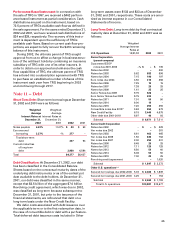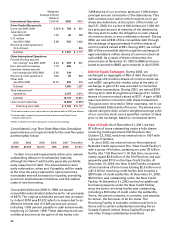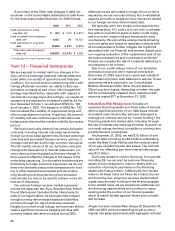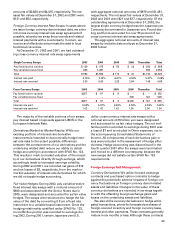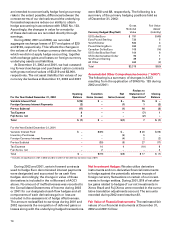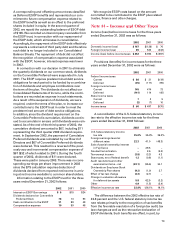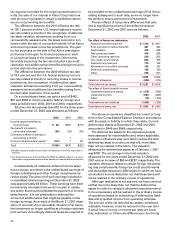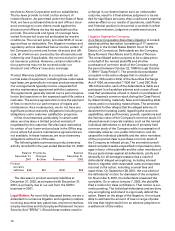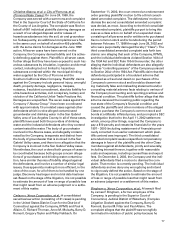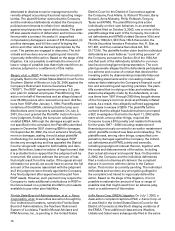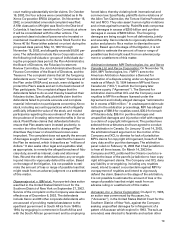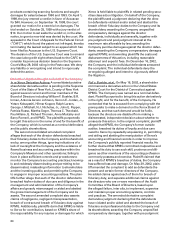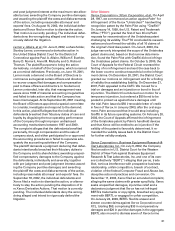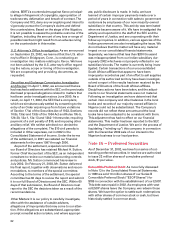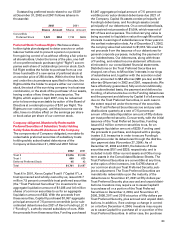Xerox 2002 Annual Report Download - page 76
Download and view the complete annual report
Please find page 76 of the 2002 Xerox annual report below. You can navigate through the pages in the report by either clicking on the pages listed below, or by using the keyword search tool below to find specific information within the annual report.
tax expense recorded for the ongoing examination in
India, the sale of our interest in Katun Corporation as
well as recurring losses in certain jurisdictions where
we are not providing tax benefits.
The difference between the 2001 effective tax rate
of 126.1 percent and the U.S. federal statutory income
tax rate relates primarily to the recognition of deferred
tax asset valuation allowances resulting from our
recoverability assessments, the taxes incurred in con-
nection with the sale of our partial interest in Fuji Xerox
and recurring losses in low tax jurisdictions. The gain
for tax purposes on the sale of Fuji Xerox was dispro-
portionate to the gain for book purposes as a result
of a lower tax basis in the investment. Other items
favorably impacting the tax rate included a tax audit
resolution and additional tax benefits arising from prior
period restructuring provisions.
The difference between the 2000 effective tax rate
of 19.1 percent and the U.S. federal statutory income
tax rate relates primarily to recurring losses in low tax
jurisdictions, the recognition of deferred tax asset
valuation allowances resulting from our recoverability
assessments and additional tax benefits arising from
the favorable resolution of tax audits.
On a consolidated basis, we paid a total of $442,
$57 and $354 in income taxes to federal, foreign and
state jurisdictions in 2002, 2001 and 2000, respectively.
Total income tax expense (benefit) for the three years
ended December 31, 2002 was allocated as follows:
2002 2001 2000
Income taxes (benefits) on
income (loss) $ 60 $497 $(70)
Tax benefit included in
minorities’ interests(1) (55) (23) (20)
Cumulative effect of change in
accounting principle – 1 –
Common shareholders’ equity(2) (173) 1 38
Total $(168) $476 $(52)
1 Benefit relates to preferred securities’ dividends as more fully described in
Note 16.
2 For dividends paid on shares held by the ESOP, tax effects of items in accumu-
lated other comprehensive loss and tax benefit on nonqualified stock options.
In substantially all instances, deferred income taxes
have not been provided on the undistributed earnings of
foreign subsidiaries and other foreign investments car-
ried at equity. The amount of such earnings included in
consolidated retained earnings at December 31, 2002
was approximately $5 billion. These earnings have been
permanently reinvested and we do not plan to initiate
any action that would precipitate the payment of income
taxes thereon. It is not practicable to estimate the
amount of additional tax that might be payable on the
foreign earnings. As a result of the March 31, 2001 dispo-
sition of one-half of our ownership interest in Fuji Xerox,
the investment no longer qualifies as a foreign corporate
joint venture. Accordingly, deferred taxes are required to
be provided on the undistributed earnings of Fuji Xerox,
arising subsequent to such date, as we no longer have
the ability to ensure permanent reinvestment.
The tax effects of temporary differences that give
rise to significant portions of the deferred taxes at
December 31, 2002 and 2001 were as follows:
2002 2001
Tax effect of future tax deductions
Research and development $ 1,142 $ 1,007
Post-retirement medical benefits 487 464
Depreciation 475 438
Net operating losses 416 295
Other operating reserves 230 202
Tax credit carryforwards 204 185
Restructuring reserves 174 122
Allowance for doubtful accounts 162 182
Deferred compensation 159 180
Other 356 207
3,805 3,282
Valuation allowance (524) (474)
Total deferred tax assets $ 3,281 $ 2,808
Tax effect of future taxable income
Installment sales and leases $ (376) (358)
Unearned income (987) (820)
Other (76) (150)
Total deferred tax liabilities (1,439) (1,328)
Total deferred taxes, net $ 1,842 $ 1,480
The above amounts are classified as current or long-
term in the Consolidated Balance Sheets in accordance
with the asset or liability to which they relate. Current
deferred tax assets at December 31, 2002 and 2001
amounted to $449 and $548, respectively.
The deferred tax assets for the respective periods
were assessed for recoverability and, where applicable,
a valuation allowance was recorded to reduce the total
deferred tax asset to an amount that will, more likely
than not, be realized in the future. The valuation
allowance for deferred tax assets as of January 1, 2001
was $187. The net change in the total valuation
allowance for the years ended December 31, 2002 and
2001 was an increase of $50 and $287, respectively. The
valuation allowance relates to certain foreign net operat-
ing loss carryforwards, foreign tax credit carryforwards
and deductible temporary differences for which we have
concluded it is more likely than not that these items will
not be realized in the ordinary course of operations.
Although realization is not assured, we have conclud-
ed that it is more likely than not that the deferred tax
assets for which a valuation allowance was determined
to be unnecessary will be realized in the ordinary course
of operations based on scheduling of deferred tax liabil-
ities and projected income from operating activities.
The amount of the net deferred tax assets considered
realizable, however, could be reduced in the near term
if actual future income or income tax rates are lower
than estimated, or if there are differences in the timing
74



